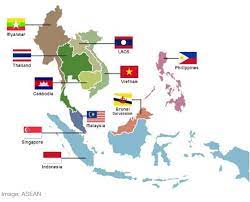The Association of Southeast Asian Nations (ASEAN) is a regional intergovernmental organization comprising of ten countries in Southeast Asia. Established in 1967, the member states of ASEAN are Brunei Darussalam, Cambodia, Indonesia, Laos, Malaysia, Myanmar, the Philippines, Singapore, Thailand, and Vietnam. The organization aims to promote economic, political, and cultural cooperation among its member states, as well as with other countries outside the region.

Table of Contents
History of ASEAN
The idea of forming a regional organization to promote economic, social, and cultural cooperation among Southeast Asian countries was first discussed in 1961. However, it was not until 1967 that the Association of Southeast Asian Nations (ASEAN) was established with the signing of the ASEAN Declaration by the five founding members: Indonesia, Malaysia, the Philippines, Singapore, and Thailand. Over the years, the organization has expanded to include Brunei Darussalam, Cambodia, Laos, Myanmar, and Vietnam.
Structure of ASEAN
ASEAN is composed of three main bodies: the ASEAN Summit, the ASEAN Coordinating Council, and the ASEAN Secretariat. The ASEAN Summit is the highest decision-making body of the organization, and it meets annually to discuss issues and challenges facing the region. The ASEAN Coordinating Council, on the other hand, is responsible for implementing decisions made by the ASEAN Summit. It comprises the foreign ministers of each member state and meets twice a year. The ASEAN Secretariat is the administrative arm of the organization and is responsible for coordinating and facilitating the work of ASEAN’s various bodies.
Significance of ASEAN
ASEAN plays a significant role in promoting regional cooperation, economic integration, and political stability in Southeast Asia. One of its major achievements is the establishment of the ASEAN Free Trade Area (AFTA), which aims to reduce barriers to trade and investment within the region. The AFTA has helped to increase trade between ASEAN member states and has attracted more foreign investment to the region.
Another important initiative by ASEAN is the ASEAN Economic Community (AEC), which seeks to create a single market and production base in the region. The AEC aims to achieve greater economic integration by reducing tariffs and non-tariff barriers to trade, harmonizing regulations and standards, and facilitating the movement of goods, services, and skilled labor within the region.
ASEAN is also actively involved in promoting regional security and stability. The organization has established the ASEAN Regional Forum (ARF), which brings together the foreign ministers of ASEAN member states and other countries in the Asia-Pacific region to discuss security issues and promote dialogue and cooperation in the region. ASEAN has also played a significant role in resolving conflicts in the region, including the Cambodian conflict and the South China Sea disputes.
Conclusion
In conclusion, ASEAN has played a critical role in promoting regional cooperation, economic integration, and political stability in Southeast Asia. Through its various initiatives and programs, ASEAN has helped to increase trade, attract foreign investment, and promote regional security and stability. As the region continues to face new challenges and opportunities, ASEAN will remain an important organization for promoting cooperation and integration among its member states and with other countries in the region.
Important Links